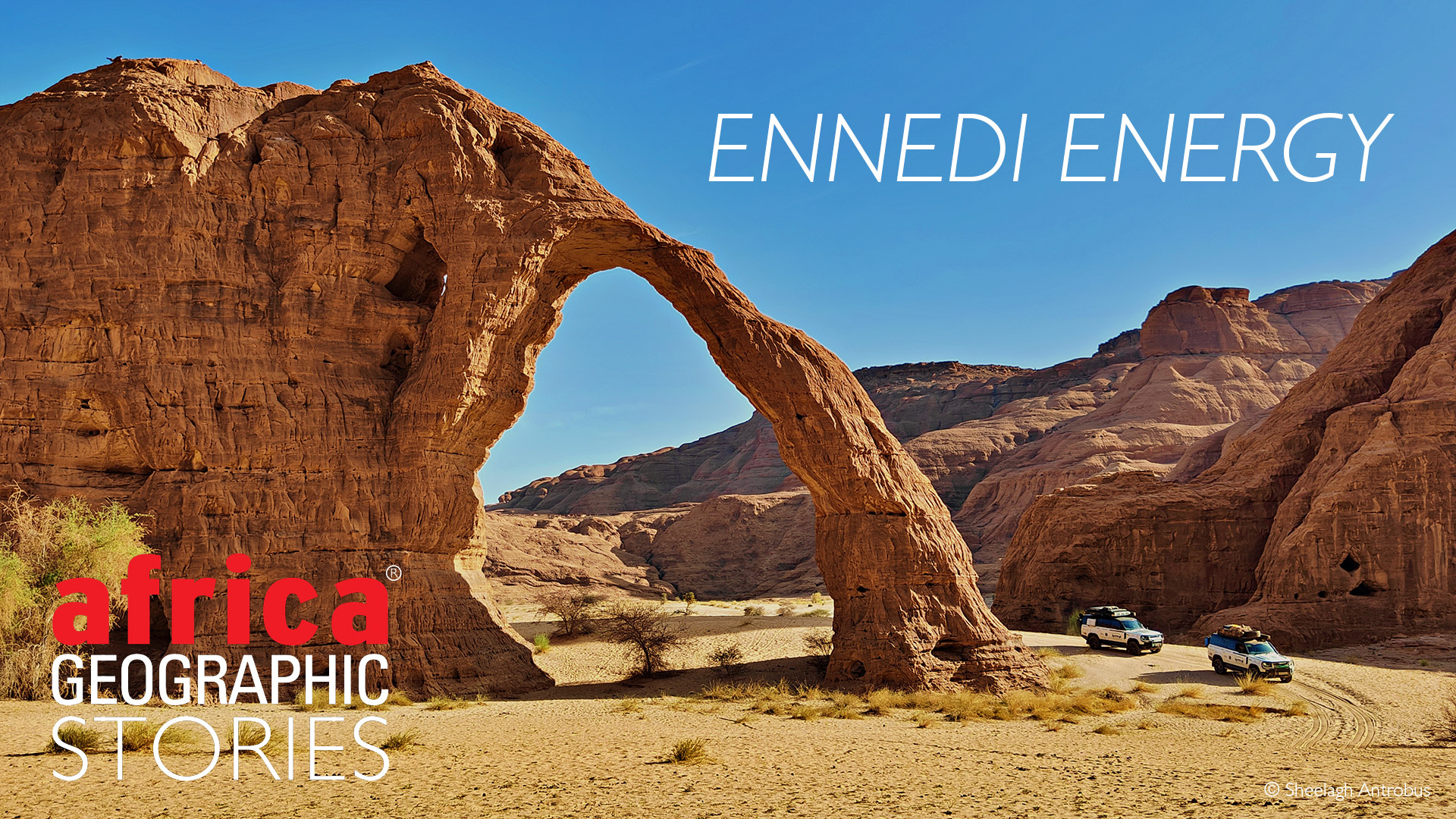
KINGSLEY HOLGATE'S AFRIKA ODYSSEY EXPEDITION


Crossing Chad, you get the feeling of distance, time and space. It’s the fifth largest country in Africa, with much of its northern part lying in the Sahara. Bordered by Sudan in the east, the Central African Republic in the south, Cameroon, Nigeria and Niger in the west and Libya in the north, Chad is sometimes referred to as ‘the dead heart of Africa’. This not only refers to its central position but also to the reality that it is simply so dry and, at this time of the year, brutally hot; all of us are careful to add electrolytes to our water bottles daily.
And so, our Afrika Odyssey expedition to link all 22 African Parks-managed wildlife areas across the continent grinds northwards towards the Chad/Libyan border, the three overloaded Defenders one behind the other. Ross and Anna upfront, Shova Mike and Fiona next in line with Mike’s Evo bike tied down on the roof rack, and the Beard and me bringing up the rear on a gruelling traverse of the Sahel. In Arabic, ‘Sahel’ means ‘shore’ – a figurative description of the arid, southern flank of the Sahara that stretches across six countries from Senegal to Chad. Here, we’re not hassled by military or police roadblocks, and when we are stopped, the letter of invitation from African Parks paves the way forward with a salute and a smile.
Renowned African explorer Kingsley Holgate and his expedition team from the Kingsley Holgate Foundation recently set off on the Afrika Odyssey expedition – an 18-month journey through 12 African countries to connect 22 national parks managed by African Parks. The expedition’s journey of purpose is to raise awareness about conservation, highlight the importance of national parks and the work done by African Parks, and provide support to local communities. Follow the journey: see stories and more info from the Afrika Odyssey expedition here.


Our stomachs rumble with hunger; the heat beats down with a vengeance. We stop at a remote market town with milling herds of camels, goats and sheep for sale, roadside stalls filled with goods from Nigeria and Cameroon, big six-wheel-drive desert trucks loaded high with smuggled drums of fuel from Libya vying for space, and fierce-looking desert nomads in turbans and robes choking the narrow alleyways. Sizzling on the coals of a desert shisanyama café are roughly chopped pieces of fat-tailed sheep. We choose a large leg and soon, using thumbs and forefingers, we’re digging into chunks of roasted mutton served on a large, round tin tray with red-hot chilli powder and salt, and using flat, round loaves of bread called ‘mapa’ to soak up the juices. This gastronomic adventure washed down with big mugs of hot, sweet ginger tea. It’s like we’ve died and gone to heaven!
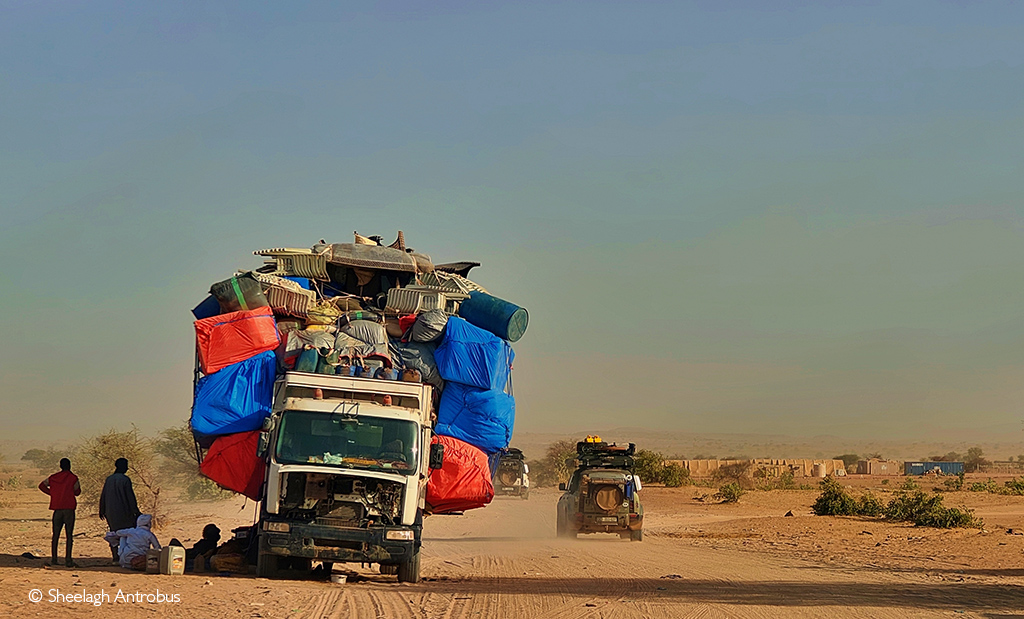
The sand track to the Sahara outpost of Fada seems never-ending and is tough on the Defenders. To avoid the thick, billowing powder dust, each Landy takes its path, knowing that all roads eventually lead to Fada, but at the same time, we have to keep sight of each other – it’s easy to get lost out here. After too much mutton and bread, we’d do anything to throw out our bedrolls under a stunted thorn tree for an afternoon nap, but we must push on in a race against the setting sun. We don’t want to travel this winding route in the dark; already, we’re battling to follow the windblown tracks of Issakha Daoussa, the African Parks driver now guiding us to their base camp.
Suddenly, Issakha veers off the track; we hurriedly hit the Defenders’ sand mode and high-lift buttons, speeding up and over-dilating dunes. On the other side is a surprise opening in a massive, free-standing rock formation – a natural tunnel large enough to drive the Landies through. Beyond, a mindboggling sunset vista turns the rocky outcrops and desert sands into an other-worldly, red-gold picture of beauty, the likes of which none of us have ever seen before. We’re all speechless – and this is just the beginning.
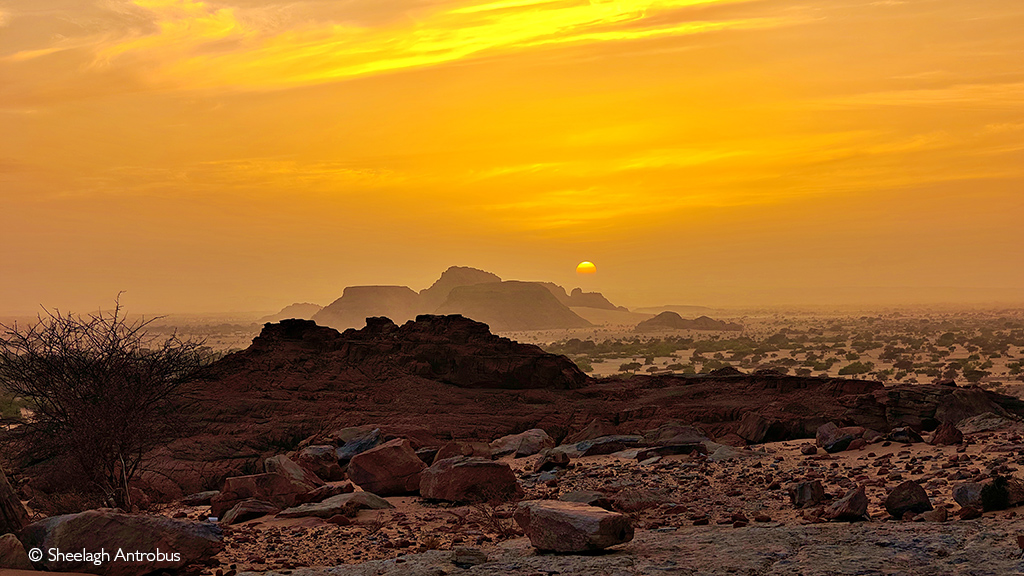

What a welcome to the Ennedi Natural and Cultural Reserve. Co-managed by African Parks and the Chadian government, it spans 40,000 square kilometres of natural, sculpted landscapes marked by sandstone cliffs, giant labyrinths, rippling dunes dotted with scrubby grasses and water catchments. Known as the Eden of the Sahara, the reserve lies within the Ennedi Massif, a mountainous refuge declared a World Heritage Site in 2016 for its unique natural formations and globally significant rock art.
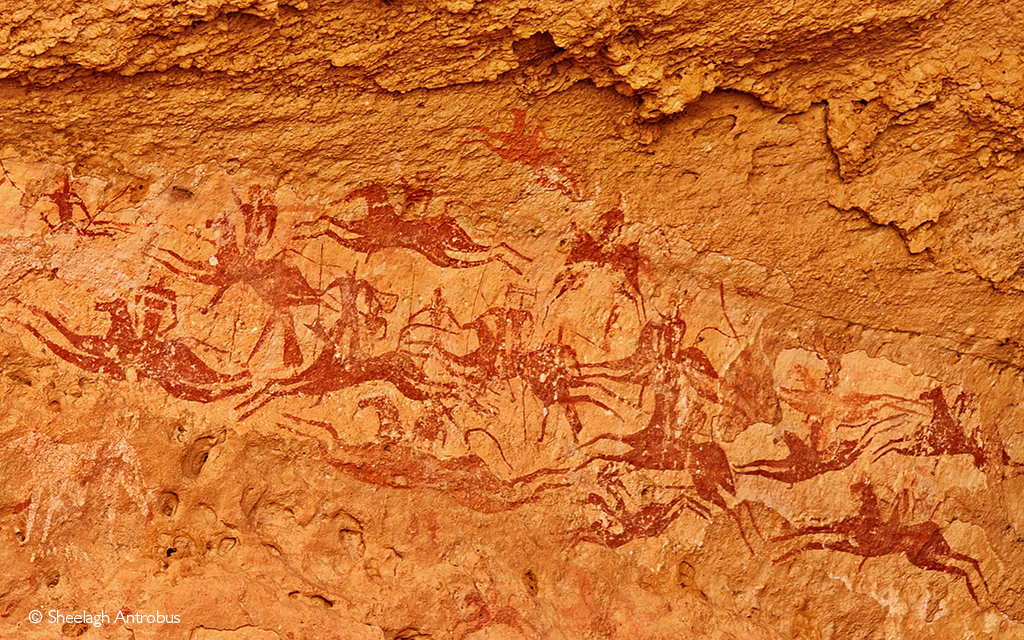
Following each other’s taillights, we finally reach African Parks’ HQ outside Fada, where a line of paraffin lanterns guide us into the newly built Oundoubah Camp. Set in a small theatre of sandstone cliffs, the simple canvas tents are clad in traditional, hand-woven palm-frond mats, each with an outdoor bathroom fashioned from stone. The units are so beautifully crafted that they blend into the surrounding sea of sand and rock. We’re told that our expedition team are the camp’s first visitors.
Ennedi is park number 19 of this quest, and what a privilege to meet up with Erik Mararv (African Parks’ regional manager for Central Africa), together with Jonas Eriksson and Manon Jampy, whom we last saw a few weeks ago at Odzala-Kakoua National Park in Congo-Brazzaville. Around the campfire, we’re joined by Ennedi park manager Issakha Guirki, Jean Didier Akpona (head of logistics) and a visiting scientist from Austria. As always with African Parks, it’s an interesting bunch of people, all with a common goal of preserving Africa’s wild spaces and supporting local communities.
 DID YOU KNOW that African Parks offers safari lodges and campsites where 100% of tourism revenue goes to conservation and local communities? You can view and book accommodation in Odzala-Kokoua National Park here, or view other African Parks destinations by clicking here.
DID YOU KNOW that African Parks offers safari lodges and campsites where 100% of tourism revenue goes to conservation and local communities? You can view and book accommodation in Odzala-Kokoua National Park here, or view other African Parks destinations by clicking here.
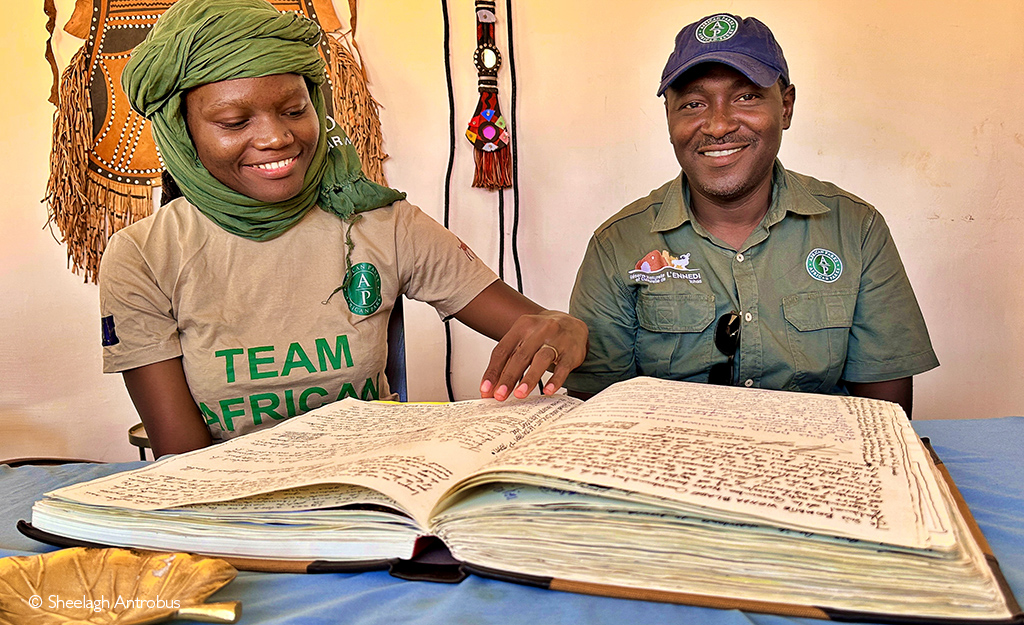
It’s also an excellent opportunity to discuss logistics for Shova Mike’s long-awaited traverse of Ennedi by bicycle. “Mike, you are aware of the heat? Today was 49°C – you’ll need lots of water,” says Erik between mouthfuls of delicious food served by the two jolly lady cooks in charge of the camp kitchen. We explain that Shova Mike has cycled much of the way here through intense heat, so he is well-salted by now. We add that his many adventurous exploits include every Cape Epic mountain bike race and climbing Mt Everest twice as part of completing the Seven Summits of the World mountaineering challenge. We all agree he’s completely crazy! But for Mike’s safety, an African Parks vehicle with rangers and armed soldiers will accompany us on our journey through Ennedi.
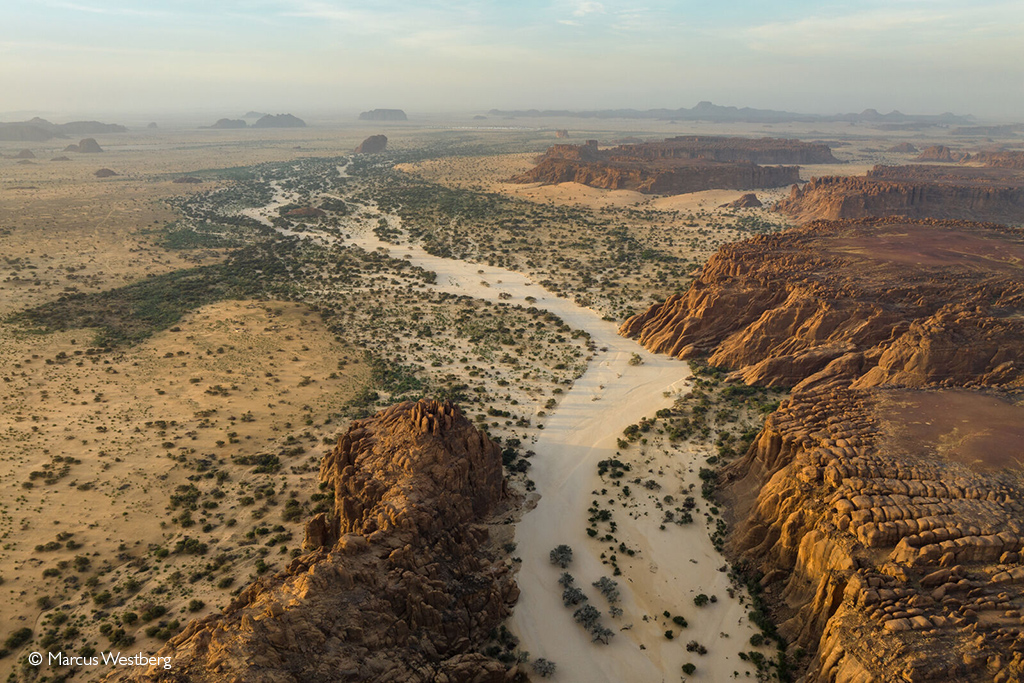
It turns out to be a truly magnificent adventure. One day rolls into the next, and we camp wild every night with a canopy of desert stars glittering overhead, surrounded by the wondrous solitude and grandeur of the most beautiful part of the nine million-square-kilometre Sahara, the largest hot desert in the world. Ennedi is like nowhere else on Earth; we feel like Lilliputians dwarfed by the 80-metre-high Arch of Aloba, the second-highest natural arch in the world, that defies gravity.
Further out in the desert, we come across the shattered, abandoned remnants of Gaddafi’s tanks, destroyed in the 1987 Battle of Fada between Chad and Libya, now burnished bronze by sun, wind and sand. At the Guelta d’Archei (‘guelta’ is a small desert pond fed by natural drainage or springs), Ross and Anna walk beneath towering sandstone cliffs and through grunting, gurgling, thirst-quenching camels for a sighting of the tiny, relic population of West African crocodiles that amazingly still survive here.
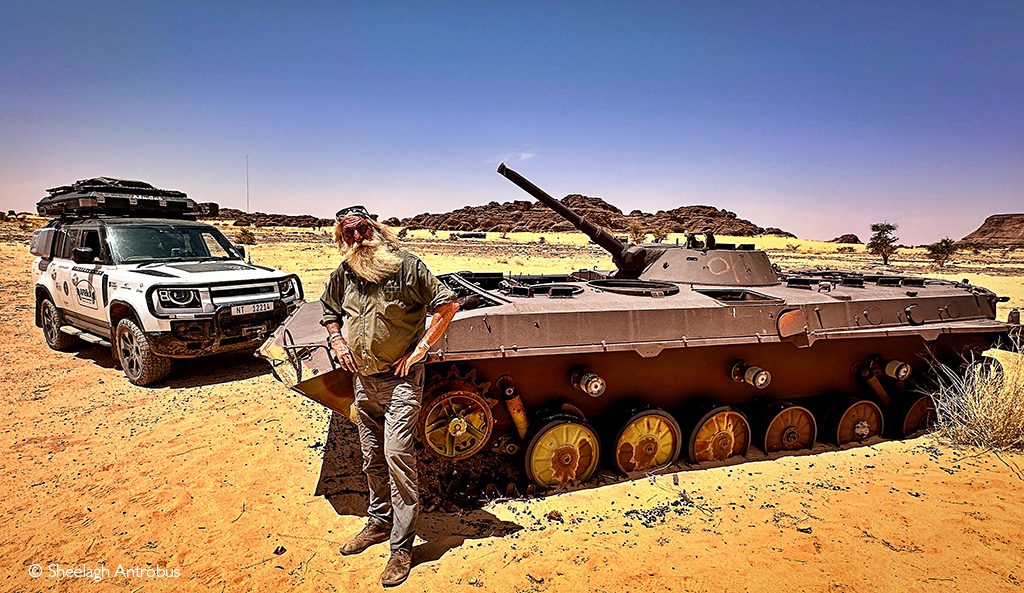
In his book The life of my choice, Wilfred Thesinger – one of the greatest explorers of the 20th century known for his pioneering journeys through the deserts of Arabia and North Africa – describes his visit to Ennedi in 1938. He wrote, “Beyond the Wadi Hauash; we followed the western edge of the Ennedi Massif where a series of plateaus, weathered peaks and pinnacles rose 5,000 feet and were intercepted by sheer-sided gorges. In their rock faces were many caves, in some of which I found paintings in different colours, depicting hunting scenes, horsemen, camels, long-horned cattle, and human figures clothed and naked…”
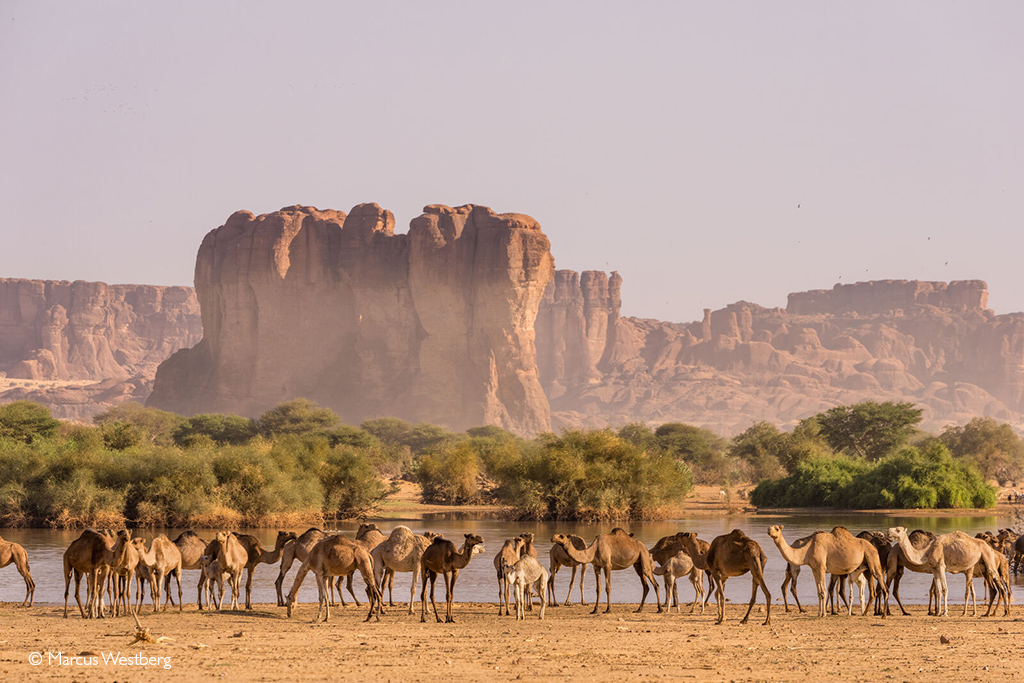
That was 86 years ago, and today, African Parks and a team of archaeologists are finding and mapping undiscovered caves of prehistoric art, shards of pottery, grinding stones and human remains dating back 7,000 years. Some 30,000 people of the nomadic Toubou and Bideyat tribes still traverse this harshly beautiful region, following their age-old cultural traditions.
In a wire-bound notebook, Kingsley sketches some of the sandstone rock formations that seem to grow out of the Saharan sands of this Star Wars-like landscape. Around the campfire, it’s a game of words to try and describe their incredible shapes: crocodiles and turtles, dynasties of dinosaurs, skeletal fingers reaching for the sky, sentinels guarding desert passageways, jumbles of juggernauts, minarets, chess pieces and fallen dominoes. Our imaginations flow… mushrooms and organ flutes, chimney stacks, beer bottles and wine goblets, calabashes, camels, obelisks, towering plum puddings, dragons and Easter Island-type heads.
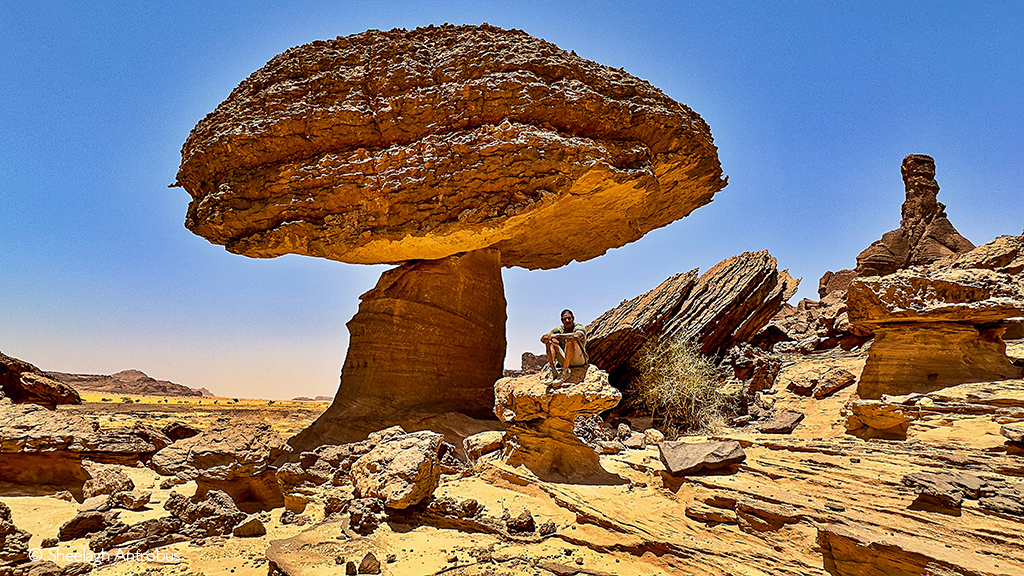
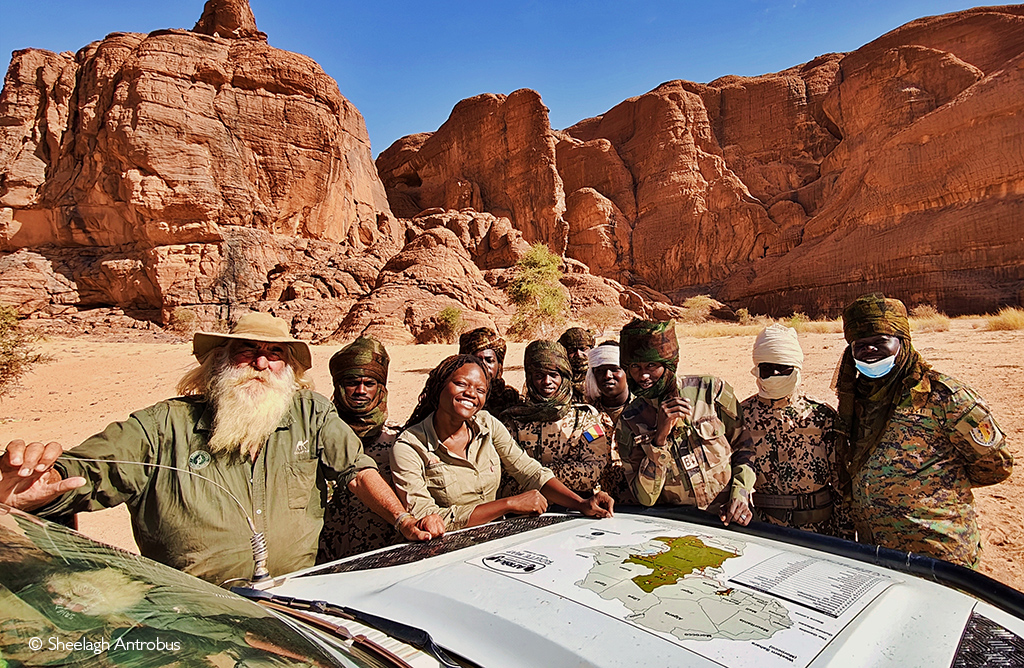
And so it goes on into the starlit night – not forgetting all the rock paintings we’ve seen dating back to when the Saraha was once verdant and shimmered with lakes. The fantastical art depicts elephants, rhinos, giraffes and ostriches, cows of every shape and colour, hunting parties, men on horseback, dancers with tall, plumed headdresses and elongated figures. It’s good that African Parks is not only educating communities about the historical importance of preserving these ancient paintings but also reintroducing wildlife species, including red-necked ostriches, scimitar-horned oryx and critically endangered addax antelope, which once roamed this region in abundance. Ennedi is also home to 500 plant species, huge Arabian bustards and iconic desert-dwelling mammals such as Barbary sheep, Dorcas gazelle, honey badgers, desert hedgehogs, striped hyenas, porcupines and rock hyrax.

Shova Mike on his Evo bike is doing great. Up well before sunrise to beat the heat, he gets to experience this incredible terrain on two wheels, but it’s increasingly tough going as the temperature rises into the mid-50s. One day, we meet him at a small, isolated village called Bachekelé, the residents living in huts simply crafted from handwoven grass mats and where African Parks has built a school. In typical fashion, Mike’s enlisted the help of an interpreter and gathered poor-sighted elderly people for eye tests and reading glasses. Mike completes his two-wheel journey across Ennedi – another ‘first’ in his long line of adventures.

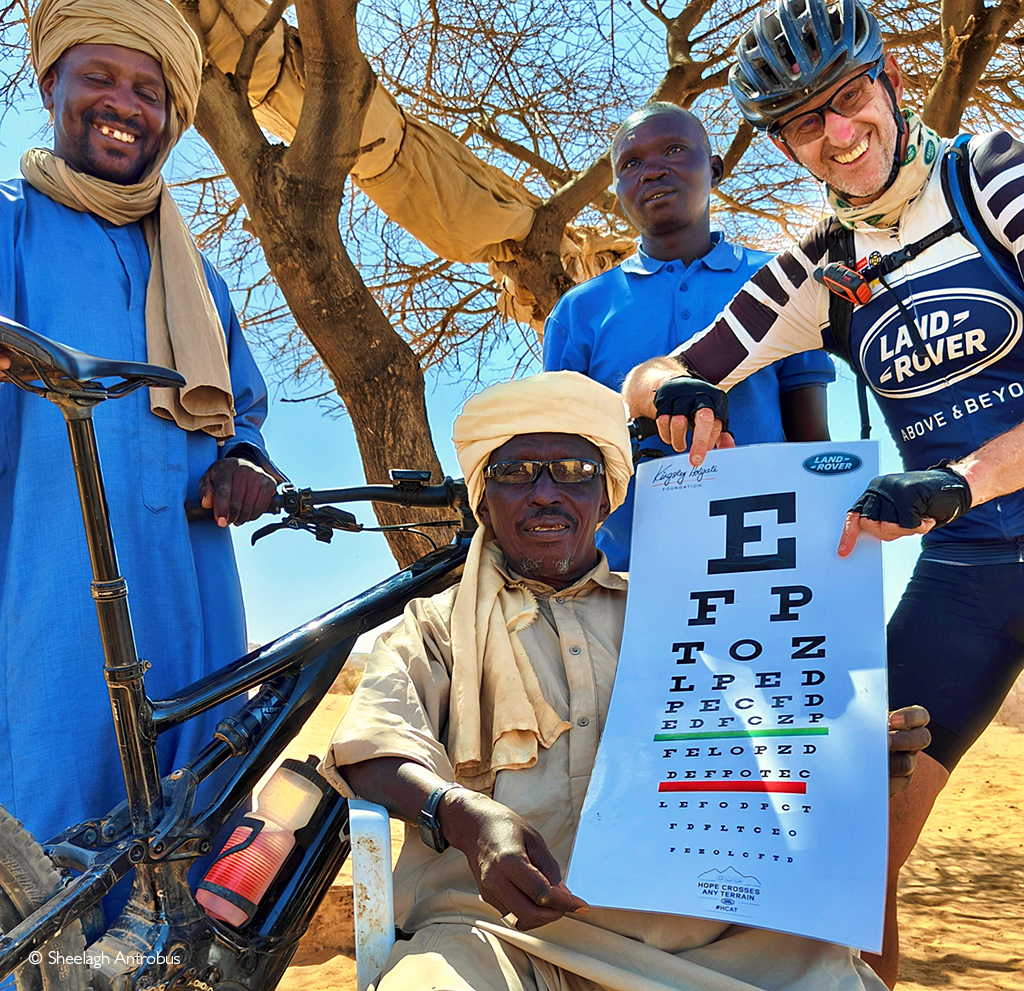
Back in Fada and working with the Ennedi community team, we visit La Patience Primary School. Animated children, primarily girls in pretty headscarves, get busy with the Wildlife Art competition, their polite voices sounding like a chattering flock of weaver birds, and the history of the Sahara written on their faces. Then, in the shade of a nearby neem tree, despite the heat, a large group of elderly, poor-sighted people gather patiently for eye tests and reading glasses. We’re deeply touched by the respect, patience and care shown to these old folk. As always, these events remind us that conservation’s future, even in a remote desert landscape like this, lies with neighbouring communities.
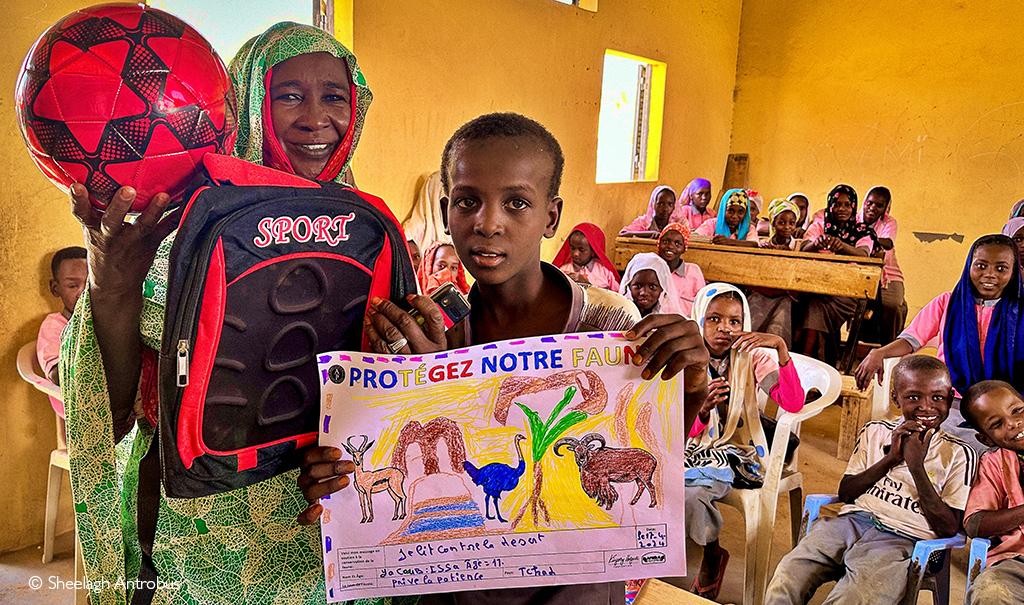
Thanks to the work of African Parks and the Chad government, Ennedi’s energy is incredible. Tormented and shaped by heat, wind, weathering, erosion and aeons of time, it remains a story of hope for conservation. Only a fortunate few get to experience its magic; hopefully, like us, some of you will too.

Saying farewell to the Ennedi team who’ve added Fada oasis water to the expedition calabash and written messages of hope in the Scroll for Conservation, we turn the battered expedition Defenders towards West Africa. Ahead lies an arduous journey through the badlands of northern Cameroon and across Nigeria to reach Benin and two of Africa’s most remote and somewhat unknown national parks, which are right on the edge of extremism and insurgency. We trust that the Zen of Travel will continue to ride with us.

Further reading
- Camels, nomads, and an oasis in Ennedi: Australian photographers, Kym and Tonya Illman, explore the towering rock formations of the Ennedi Plateau alongside Toubou nomads and their camels. Read more here.
- The Ennedi Plateau, Chad, is home to cultural rock art treasures. Read more about the protection of these rock art sites.
To comment on this story: Login (or sign up) to our app here - it's a troll-free safe place 🙂.![]()




